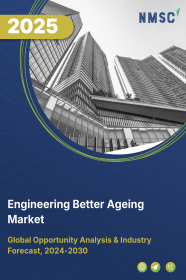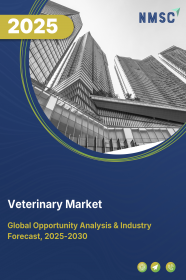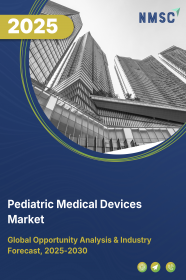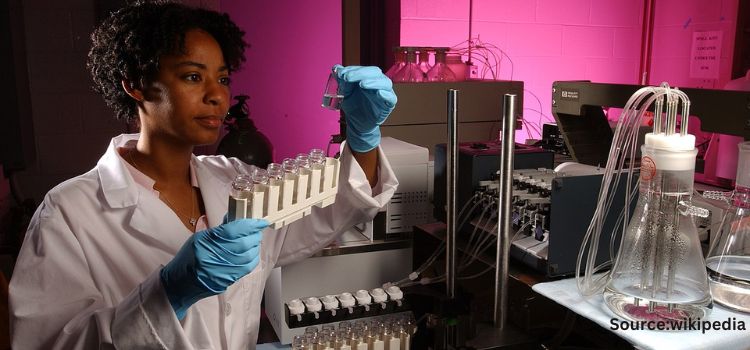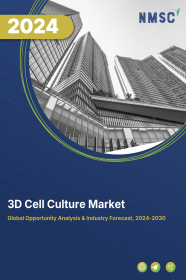
3D Cell Culture Market by Technology (Scaffold-based Systems, Scaffold-free Systems, Microfluidics-based Systems, Magnetic Levitation, and Others), by Application (Stem Cell Research, Drug Discovery and Development, Tissue Engineering and Regenerative Medicine, Neuroscience, and Others), and by End-User (Academic and Research Institutes, Clinical and Diagnostic Laboratories, Pharmaceutical, and Biotechnology Companies) – Global Opportunity Analysis and Industry Forecast, 2024–2030
US Tariff Impact on 3D Cell Culture Market
Trump Tariffs Are Reshaping Global Business
3D Cell Culture Market Overview
The global 3D Cell Culture Market size was valued at USD 1.83 billion in 2023 and is predicted to reach USD 5.34 billion by 2030 with a CAGR of 16.4% from 2024-2030. The market, also referred to as 3D cell modelling market, involves technologies and systems that creates three-dimensional environments for growing and studying cells.
This organoid technology comprises various systems designed to reproduce the complex cellular conditions found in living organisms, offering a more accurate model for research and therapeutic applications.
3D cell cultures offer several advantages over 2D cultures by providing a more realistic three-dimensional environment that closely mimics physiological conditions. These leads to the enhance stem cell differentiation, more accurate drug testing, and safer studies of viral infections.
This system is applied in drug discovery, disease modelling, drug delivery, stem cell research, and the development of cell therapies that are suitable for a wide range of mammalian cell types, highlighting their versatility and significant role in advancing biomedical research and therapeutic innovation.
Market Dynamics and Trends
The rising prevalence of chronic conditions such as cancer, cardiovascular diseases, diabetes, and others worldwide fuels the need for advanced research tools and therapies, thereby driving the 3D cell culture market demand. These technologies offer more accurate and relevant insights into these complex diseases, enhancing the ability of researchers to identify new therapeutic targets and test treatments more effectively.
According to the latest report published by WHO (2024), there were approximately 20 million new cancer cases and 9.7 million deaths in 2022. The report predicts that by 2050, the number of new cancer cases will increase to over 35 million, marking a 77% rise from the 2022 figures. The surge in cancer cases highlights the need for innovative research tools to address the growing challenge of chronic diseases and improve therapeutic outcomes.
Moreover, increased investment in research and development within the healthcare sector drives the 3D cell culture market growth by fostering advancements in medical technologies and therapeutic solutions.
The Ministry of Health and Welfare reported that India’s healthcare budget was around USD 10.69 billion in 2023, with approximately USD 36 million dedicated to health research. Additionally, in Australia, the healthcare budget for 2022 was about USD 71.9 billion, including USD 10.4 billion allocated to the Medical Research Future Fund. This rise in funding supports the continued development and application of spheroid culture systems, contributing to more advanced and effective medical research and treatments.
Furthermore, the advancement of 3D technology in cell culture accelerates market growth by improving the application and utilization of 3D cell cultures. These models offer superior accuracy in predicting drug efficacy and toxicity compared to traditional 2D methods.
For instance, in June 2024, Predictive Oncology introduced an advanced 3D cell culture model to enhance cancer drug discovery and development. These organ-specific 3D cell cultures more accurately replicate human tissue environments than traditional 2D models, allowing for better predictions of drug efficacy and toxicity. Such advancement highlights the important role of tissue engineering in improving drug discovery and development.
However, high costs associated with the setup and maintenance of 3D cell culture systems, including advanced equipment, specialized media, and reagents, are restraining the 3D cell culture market expansion.
On the contrary, the integration of stem cell research with organ-on-chip technology creates a significant growth opportunity for the 3D cell culture market as it enhances the precision and realism of in vitro models for drug testing, disease modelling, and personalized medicine.
The combination of the advanced structural and functional capabilities of 3D cell cultures with the microfluidic systems of organ-on-chip platforms allows researchers to better mimic human organ behaviour, improving the accuracy of preclinical testing.
The synergy addresses the limitations of traditional 2D cultures and animal testing, driving pharmaceutical companies, biotech firms, and research institutions to adopt these advance technologies.
Market Segmentations and Scope of the Study
The 3D cell culture market report is segmented on the basis of technology, application, end-user, and region. Based on technology, the market is divided into scaffold-based systems, scaffold-free systems, microfluidics-based systems, magnetic levitation, and others. Based on application, the market is divided into stem cell research, drug discovery and development, tissue engineering and regenerative medicine, neuroscience, and others. On the basis of end-user, the market is categorised into academic and research institutes, clinical and diagnostic laboratories, pharmaceutical, and biotechnology companies. Regional breakdown and analysis of each of the aforesaid segments includes regions, such as North America, Europe, Asia-Pacific, and the Rest of the World (RoW).
Geographical Analysis
North America dominates the 3D cell culture market share and is expected to maintain its dominance during the forecast period. This is due to the increasing cases of chronic diseases such as cancer, diabetes, and cardiovascular conditions. These models provide more accurate simulations of human tissue and disease states, allowing for better understanding and development of targeted therapies.
According to the National Cancer Institute, in 2024, around 2 million people were diagnosed with cancer in the U.S., and around 611,720 people lose their lives due to cancer. The rising prevalence of such chronic conditions increases the need for advanced research technologies, thereby ensuring continued market growth and innovation in the region.
Moreover, increased funding in research and development from both government and private sectors drives advancements in 3D cell culture technologies, leading to more sophisticated and effective solutions and thereby fuelling the market growth in this region.
As per latest report published by the American Cancer Society, in 2024, the National Institutes of Health (NIH) received USD 300 million to conduct and support medical research. This substantial investment in research is set to enhance the development of innovative 3D cell culture models, further propelling market growth in the region.
On the other hand, Asia-Pacific region is expected to witness significant growth in the 3D cell culture market trends. Increased government funding and support for healthcare infrastructure in this region drive the growth of the market by enabling greater access to advanced research technologies.
As per the report published by the Organisation for Economic Co-operation and Development, in 2022, total health spending per capita in Japan reached USD 5,250.60. This investment reflects a strong commitment to advancing healthcare, that is expected to further boost the adoption and development of 3D cell culture technologies across the region.
Additionally, technological advancement and innovation towards cell-based assays drive the growth of the market in the region by introducing advanced tools that enhance research capabilities.
For example, in September, 2024, Inventia Life Science and Biotron Healthcare collaborated to introduce the RASTRUM platform in India. This advanced 3D cell culture technology aims to enhance biomedical research by improving disease modeling and drug discovery, with its automation and precision supporting the transition from 2D to 3D cell cultures.
Competitive Landscape
Various market players operating in the 3D cell culture industry includes Thermo Fisher Scientific Inc., Corning Inc., Lonza Group, Merck, ReproCELL Inc., InSphero AG, Promega Corporation, Synthecon Inc., 3D Biotek LLC, VWR International, LLC., and others.
Key Benefits
-
The 3D cell culture market report provides a quantitative analysis of the current market estimations from 2024 to 2030. This analysis assists in identifying the prevailing industry opportunities to capitalize on.
-
The study comprises an extensive analysis of the current and future 3D cell culture market trends, to depict prevalent investment pockets in the sector.
-
The information related to key drivers, restraints, and opportunities and their impact on the market is provided in the report.
-
The competitive analysis of the key players along with their market share is provided in the report.
-
The SWOT analysis and Porter's Five Forces model are elaborated in the study.
-
The value chain analysis in the market study provides a clear picture of the roles of stakeholders.
3D Cell Culture Market Key Segments
By Technology
-
Scaffold-based Systems
-
Scaffold-free Systems
-
Microfluidics-based Systems
-
Magnetic Levitation,
-
Others
By Application
-
Stem Cell Research
-
Drug Discovery and Development
-
Tissue Engineering and Regenerative Medicine
-
Neuroscience
-
Others
By End-User
-
Academic and Research Institutes
-
Clinical and Diagnostic Laboratories
-
Pharmaceutical,
-
Biotechnology Companies
By Region
-
North America
-
The U.S.
-
Canada
-
Mexico
-
-
Europe
-
The UK
-
Germany
-
France
-
Italy
-
Spain
-
Denmark
-
Netherlands
-
Finland
-
Sweden
-
Norway
-
Russia
-
Rest of Europe
-
-
Asia-Pacific
-
China
-
Japan
-
India
-
South Korea
-
Australia
-
Indonesia
-
Singapore
-
Taiwan
-
Thailand
-
Rest of Asia-Pacific
-
-
Rest of the World (RoW)
-
Latin America
-
Middle East
-
Africa
-
Key Players
-
Thermo Fisher Scientific Inc.
-
Corning Inc.
-
Lonza Group
-
Merck
-
ReproCELL Inc.
-
InSphero AG
-
Promega Corporation
-
Synthecon Inc.
-
3D Biotek LLC
-
VWR International, LLC.
REPORT SCOPE AND SEGMENTATION:
|
Parameters |
Details |
|
Market Size in 2023 |
USD 1.83 Billion |
|
Revenue Forecast in 2030 |
USD 5.34 Billion |
|
Growth Rate |
CAGR of 16.4% from 2024 to 2030 |
|
Analysis Period |
2023–2030 |
|
Base Year Considered |
2023 |
|
Forecast Period |
2024–2030 |
|
Market Size Estimation |
Billion (USD) |
|
Growth Factors |
|
|
Countries Covered |
28 |
|
Companies Profiled |
10 |
|
Market Share |
Available for 10 companies |
|
Customization Scope |
Free customization (equivalent to up to 80 working hours of analysts) after purchase. Addition or alteration to country, regional, and segment scope. |
|
Pricing and Purchase Options |
Avail customized purchase options to meet your exact research needs. |

















 Speak to Our Analyst
Speak to Our Analyst



